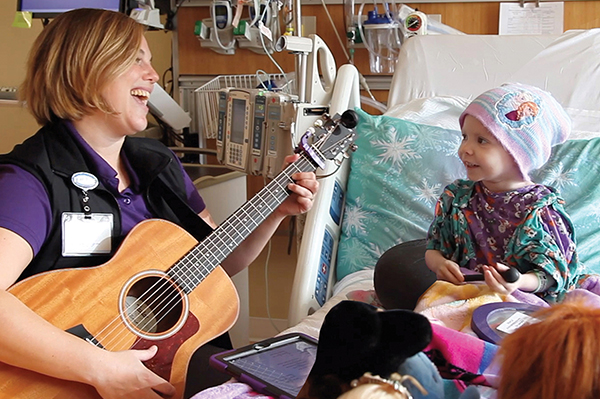Music as Medicine for Children Living with Cancer
by Maura Boyce
Hospitals can be nerve-racking. These buildings are designed for physical healing, but the equipment sounds aren’t conducive to a person’s emotional healing. The World Health Organization reports hospital noise levels make it difficult to rest, increase patient blood pressure, and interfere with pain management.
It takes more than medicine to treat cancer. That’s why more hospitals are integrating music as a complementary therapy. Interactive music interventions (including music listening) and active music engagement (like singing or selecting songs) not only muffle unpleasant sounds but may also help reduce nausea from chemotherapy and anxiety from radiotherapy. In short, music brings joy, and joy makes people feel better.
During my time leading the JoyRx Music program at pediatric healthcare facilities across the country, I have witnessed countless cases of music bringing joy and optimism to children facing pediatric cancer, their parents, and their care teams.
Here are three ways you can use music to help you or your loved one withstand cancer’s challenging moments:
1. Find your favorite tunes.
There’s a large repertoire of music available out there: from lullabies to Disney Music; Rock to Top 40 Pop; Country to Oldies; and more. Choose songs that resonate with you and the emotions you are feeling, or want to feel! Digital music streaming platforms like Spotify and Amazon Music make it easy to build playlists to take anywhere, and to share.
In short, music brings joy, and joy makes people feel better.
2. Make your own music.
Pick up a ukulele, keyboard, guitar – any instrument. Take part in bedside jam sessions or instrument lessons that promote fun, positivity, and movement.
Don’t have time to learn an instrument? Music technology, apps, and games are a terrific way to integrate music into your day. One of my favorite music apps is GarageBand, which lets you play and record music without an instrument. But there are lots of different musical games and apps available. YouTube is another great resource for music videos, lessons, and more.
It takes more than medicine to treat cancer. That’s why more hospitals are integrating music as a complementary therapy.
3. Write an original song.
At JoyRx, we occasionally help kids and teens undergoing cancer treatment write songs about their experiences with cancer, or with other serious illnesses. Songwriting helps people of all ages process thoughts and emotions that are difficult to express with spoken words. Anyone can write about feelings such as sadness, fear, and hope in a song. Try it!

Maura Boyce is the vice president of Programs with JoyRx, a national nonprofit delivering music programs that improve the emotional and physical health of young people facing cancer and other serious illnesses at 31 pediatric healthcare facilities across the country.
Talk to your doctor about integrating music into your cancer treatment experience. For more information on finding a free bedside or virtual music program, visit joyrx.org.


